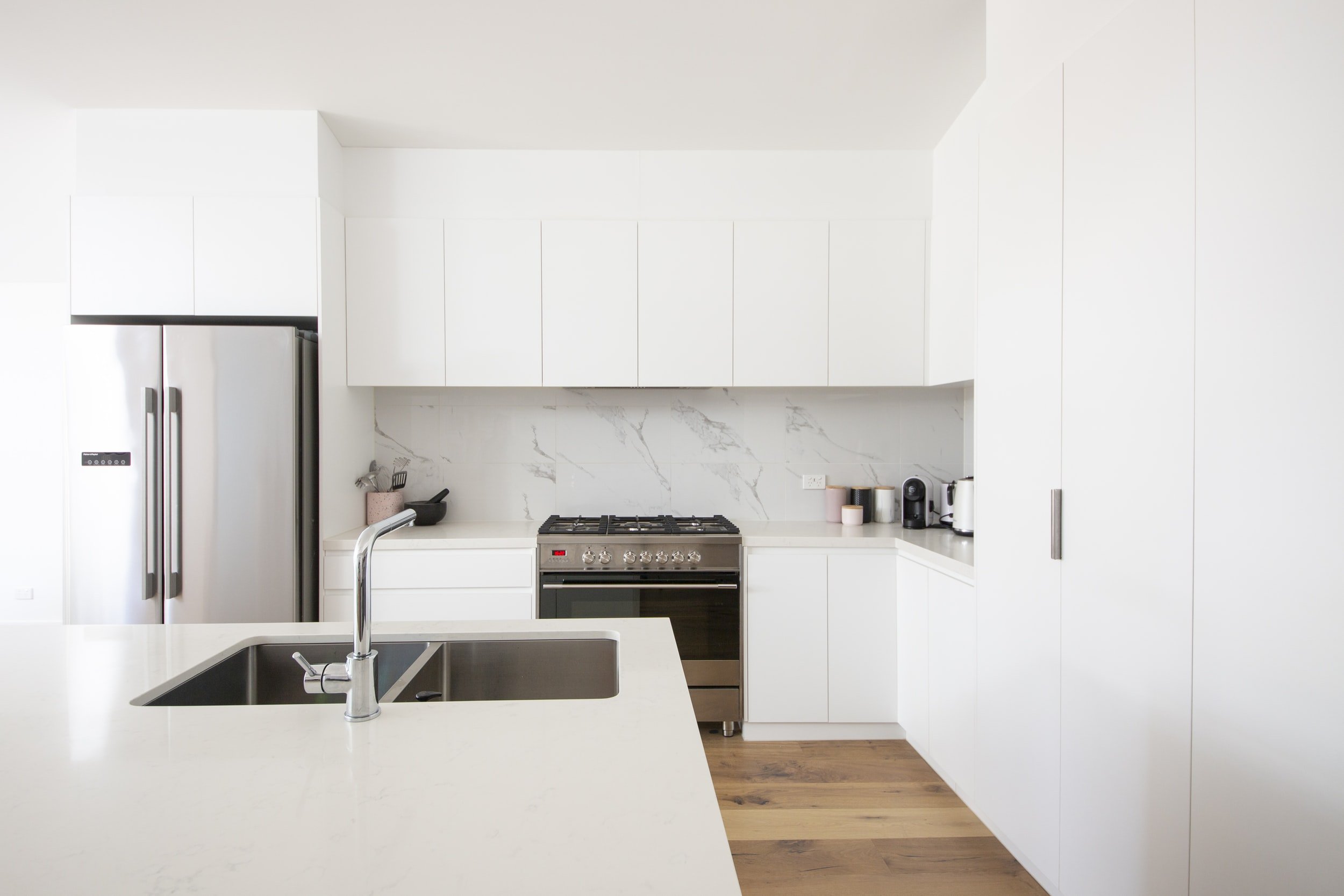Think Again Before Choosing an All White Kitchen
The all-white kitchen has recently become more popular for its clean and luxurious look and its minimalist quality. However, having a white kitchen isn’t all it’s cracked up to be. And if you’re considering turning your kitchen all white, then I advise you to keep reading so I can help save you from making what could be the most expensive mistake of your life.
Cleaning
Cleaning an all-white kitchen seems like it would be an easy job because there’s really nowhere for dirt and grime to hide. However, there are plenty of surfaces for dirt and grime to get stuck, whether it’s in the fissures of your natural stone countertop, the grout in between tiles, caulking around sinks and other appliances; I could literally go on for hours listing the different places dirt can get stuck. Furthermore, white surfaces are easily stained, especially natural stone countertops.
Keeping it clean
Now, cleaning a white kitchen is one thing, but trying to keep it clean is a whole other issue. Keeping a normal kitchen clean can already be a hassle—having to clean the cabinets weekly to get rid of oil splatter from cooking (more info on cabinet care here), wiping down countertops to clean them from dust, dirt, and spices from cooking, cleaning off watermarks and anything sticky. And if you have kids who are prone to spilling juice, don’t even bother because acid juices and liquids stain natural stone more easily, so your beautiful white natural stone countertop will soon start to get orangey-yellow or purple stains (more info on kitchen countertops here). Then, if you’re really going full-white and have white floors, you will have to clean them daily to keep them white.
Basically, your all-white kitchen will need to be deep cleaned once to twice a day to keep it all-white, and if you don’t have the time or energy to put that much effort into keeping your kitchen clean, then I would suggest against the all-white kitchen.
It never looks as good as it did when it was first installed
No matter how careful you are and how often you clean your kitchen, your all-white kitchen will never look as good as the day your whole kitchen was finished. Staining, cabinet dings, surface scratches are all inevitable in any kitchen that is actually used as a kitchen. What’s great about kitchens that aren’t all white, is that all the evidence of life is hidden in the variations of color. But with a white kitchen, those little knicks and scratches will show a whole lot more and a whole lot quicker. In addition, all the creases in the countertops and between appliances will start to yellow or gray if you aren’t on top of them.
It's hard to do properly
Designing a white kitchen isn’t as easy as one might think. Between the different finishes of countertops, cabinets, and appliances and the different shades and tones of white, you could end up with a really off-putting kitchen. When it comes to the finishes, it would probably be better to mix it up so that the kitchen has a little depth and doesn’t look like a flat photograph. One way you could do this is have the countertops a matte finish and the island a gloss finish so that it pops under some warm or cool lighting. And speaking of warm and cool lighting, you have to pay attention to the warmth or coolness in the whites that you pick. When choosing the different materials, make sure they are all one tone—whites that have yellow in them are warm and whites that have blue in them are cool. You can choose different shades of white—carefully—as long as they all have the same tone.
The dreaded hospital quality
When I see a white kitchen, I’m reminded of old-school hospitals and psych-wards, especially if it’s a minimalist kitchen. White, when used properly, is a beautiful accent that expresses class, luxury, simplicity; but when it’s not properly used it can look sterile, dull, and even unsettling.
If you like to cook a lot, it's really not a good idea
If you’re like me, then you love spending time in your kitchen cooking meals that smell amazing. And, also if you’re like me, then you know that sometimes, no matter how many times you clean and wipe things down while you’re cooking, you somehow manage to make a complete mess. Whether you’re frying chicken for chicken parmesan or sautéing vegetables, grease splatter is inevitable; whether you’re seasoning ground meat for meatballs or measuring dry ingredients for bread, there will be spices or flour on the counter and maybe on the ground. If you have a white kitchen there will be no more, “let me just quickly cut this carrot or pomegranate on the counter because it’s faster than getting a cutting board”, because there will be stains. If you like to cook, don’t get a white kitchen, because part of the joy of cooking is handling the ingredients and sometimes that can get a bit messy.
The "proper" way to design an all-white kitchen
Pay attention to tone
As I mentioned before, the tone of the white or whites you’re using matters. When deciding what tone of white you use, you have to consider the kind of kitchen you want. I’m all about the warm and inviting kitchen that welcomes you to the tea kettle in the morning, but some people would go crazy if their kitchen looked yellowish. However, if you choose cooler tones of white, you might want to make sure it doesn’t feel like an institution. Also, when designing a white kitchen, or any kitchen, you have to consider the tone of lighting. If you have a warmer white than you might want to consider a cool white light to keep your kitchen from turning yellow when the lights are on. With a cool white kitchen, if you choose too cool of lighting your kitchen might look blue when the lights are on.
Get creative
One of the most important things when designing an all-white kitchen is creativity. For example, there should be some pops of color, whether it’s a bright color like red, blue, or yellow or a more neutral and earthy color like brown, tan, or green. In addition to color, don’t be afraid to get creative with the different metals you use. While a white kitchen with silver or gold hardware and appliances can be very elegant, it’s also already been done…a lot. So, consider copper, nickel, brass, bronze and also consider the different finishes, because different hardware could have different finishes to keep everything from looking the same. Furthermore, as I mentioned earlier about the different finishes of countertops, add in some different textures. I’ve seen beautiful distressed knobs and pulls, knurled knobs and pulls, and even wood knobs and pulls designed by Ashley Norton that would really bring a lot of character to a white kitchen.
Stay away from porous stones to prevent staining and yellowing
I know I’ve mentioned staining a of couple of times throughout this blog, but it’s so important to consider because countertops are so expensive! Not only can food and drinks stain a countertop, but certain porous stones like granite and marble can yellow over time, if not properly treated regularly, from oils in our hands and foods. In addition to countertops, make sure your wall and cabinet paint isn’t an alkyd paint because they yellow quicker than latex paint.
Be daring
Going all white is anything but safe, so if you’re going to do it, don’t hold back.
A few closing thoughts
Make sure it’s really what you want and you’re not doing it because you saw a beautifully done white-out kitchen on Pinterest. Consider the layout of your kitchen, how much natural light it gets, and the size because these are all major factors when designing a kitchen. If you have a small kitchen that doesn’t get a lot of natural light, then you could end up with a kitchen that looks like a hospital room.

